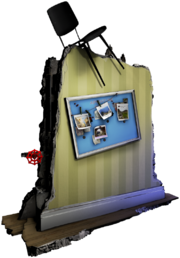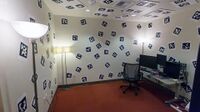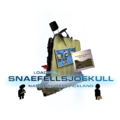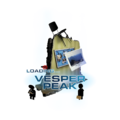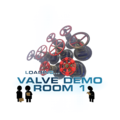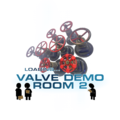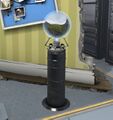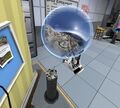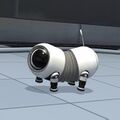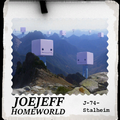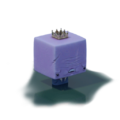Postcards
| This article is non-canon. | ||
|---|---|---|
The subject matter of this article does not take place in the "real" Half-Life and Portal universe and is considered non-canon. |
This article is a stub. Maybe you can help by expanding it. |
|---|
| This article would greatly benefit from the addition of one or more new images. | ||
|---|---|---|
Please upload one or several relevant images (from canonical / official sources) and place it here. Once finished, this notice may be removed. |
| Preceded by Sub-Universe Exploration Center |
Postcards | Succeeded by Slingshot |
|---|---|---|
| Experiment name | Description | Comments |
| Euclid-Spectrum After Greek mathematician Euclid. |
Each postcard traverses to a different location from around the world. | Move the plug to select which location you will be sent to. |
| Item: Three sticks and a Ballooninator. | ||
Postcards (in-universe name Experiment Euclid-Spectrum) is the first minigame / experiment of The Lab.
Relic[edit]
The relic in the hub, numbered 84-J, consists of the fragment of the wall of a home with yellow striped wallpaper, parts of the floorboards, a red valve, and a chair straddled on top of the wall. The postcards and their plugs are pinned to a lopsided blue frame.
Minigame[edit]
Choosing the destination from a selection of postcards by plugging a cable into their related socket, the player can teleport to digital versions of real-world locations:
- Vesper Peak in the Washington state, USA (the first area visited through a first relic before entering the hub for the first time).
- Campo S. Beneto in Venice, Italy (with the guitar track from the Counter-Strike map Italy played in the background).
- The Raufarhólshellir lava tube in Iceland.
- The Snæfellsjökull National Park, also in Iceland.
These maps are part of a larger set of maps mostly made by Valve's Adam Foster using photogrammetry.[1] The other maps can be visited within SteamVR Home; they include La Pedrera in Barcelona, a Mars landscape, the Holy Trinity Church in Kirk Ireton, Tower Bridge, the Valve Lobby, an Hawaiian Beach, and Mount Rainier.
In these four locations, the player can interact with Fetchbot, a dog-like Item Retrieval Core: scratch its belly and play fetch with the various sticks found on the ground, stated as "object retrieval training". Fetchbot subsequently appears in the hub and can be further interacted with, leading to various reactions by the Announcer.
Added to the three sticks, the Ballooninator, a balloon inflation device that creates an infinite supply of balloons and is also the quest item from SteamVR Home's Ilia's Retreat, is awarded (it was one of the earliest things to be created for The Lab[2]). The device has a color gauge that changes at random and shows what color the next balloon will be. When inflated at the right size, the balloon releases itself and flies away, and can also be shot. Overinflating balloons in the hub will lead the Announcer to first state "Excess helium detected in atmosphere of Pocket Universe Lab Eight.", then "Warning: Helium levels in Pocket Universe Lab Eight are rising.", and finally "Excess helium detected in atmosphere of Pocket Universe Lab Eight." with a high-pitched voice due the helium deforming it.
Valve Demo Rooms[edit]
The Postcards relic also features a red valve with a socket in the axle. Plugging the cable into it allows teleporting to Easter egg rooms, Valve Demo Room 1 and 2, that give a glimpse at the VR development process in photogrammetry-made replicas of rooms from Valve's headquarters, each with explanations on a clipboard:
The first demo is set in a room that was used for early experiments in developing room-scale VR. A prototype VR headset connected to a PC with a Dota 2-themed mousepad is lying on the floor, with codes plastered on the room's walls to be used by the headset's camera to track the wearer's position. A silent fire alarm near the door can also be activated after smashing the glass, which will have small turrets spring from the codes on the walls that will shoot small metallic bouncing balls that can be sent back with the ping-pong racket found on the PC's desk.
The second demo room can be accessed by putting on the VR headset lying on the floor. This room features an ATLAS robot and showcases the experiments on "Lighthouse", the laser tracking technology created for room-scale VR for the HTC Vive headset. This room, equipped with two Lighthouse base stations and a computer with a monitor showing what the player sees, is stated to have been used to showcase hundreds of different VR experiments. Another fire alarm will prompt parts of the dropped ceiling to open and release balloons that can be popped either by a pin or a laser; this area is the first instance of The Lab that implemented balloons, the latter being a early vehicle on how to do haptic feedback.[2] Getting to close to ATLAS and directing a hand near his face will scare him.
Behind the scenes[edit]
Postcards features an Easter egg that was disabled and requires patching to work. It consists of an alternate version of the Vesper Peak postcard populated with the JoeJeff characters featured in Moondust. Once the Easter egg is restored, a yellow button with a JoeJeff pictogram on it attached to a rock triggers a flood of tiny JoeJeffs coming up the hill, while JosephJeffrey,[3][4] a JoeJeff father that appears as a giant, older and mustachioed variant with a crown and growling, briefly follows later, walking above the player. Another JosephJeffrey is also seen in a lake in the valley.[5][6] The game textures still contain the relic postcard for that variant of Vesper Peak, titled JoeJeff Homeworld, although it sets it in Stalheim, Norway, instead.
A balloons scoreboard can be found in the game's texture files, suggesting points being awarded for creating balloons with the Ballooninator or bursting them, but it was actually never used by the developers.[7]
Gallery[edit]
References[edit]
- ↑ Mike Belzer on Fetchbot's backstory (August 17, 2020)
- ↑ 2.0 2.1
 Developing The Lab on YouTube
Developing The Lab on YouTube
- ↑
 Zach Tsiakalis-Brown on Twitter
Zach Tsiakalis-Brown on Twitter
- ↑ The Lab textures files
- ↑ Small Easter eggs found in the recent update to Valve's The Lab on Reddit
- ↑
 The JoeJeff Easter egg restored at Vesper Peak on YouTube
The JoeJeff Easter egg restored at Vesper Peak on YouTube
- ↑ Jeep Barnett on the unused texture for a balloons scoreboard featured in The Lab files (August 2, 2020)
